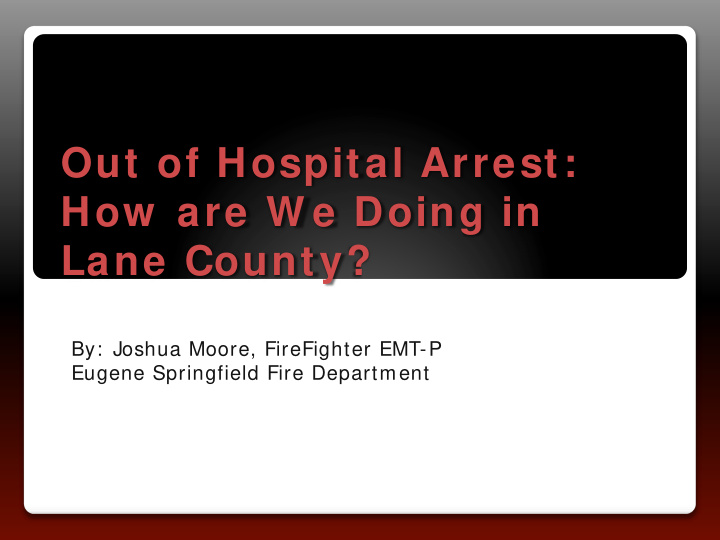



Out of Hospital Arrest: How are W e Doing in Lane County? By: Joshua Moore, FireFighter EMT-P Eugene Springfield Fire Department
Objectives: State the 5 links in the AHA “Chain of Survival.” 1. How has ACT: C3 improved our local chain? 2. How do you play a role in that chain? 3. What improvements can you develop within your 4. scope of practice?
2 Chain of Survival: 5 Links. Components of ACT: C3 ◦ Community Awareness and ◦ Early Access ◦ Early CPR CPR training ◦ Chest Compressions Oriented ◦ Early Defibrillation Dispatch Instructions ◦ Advanced Life Support ◦ CardioCerebral Resuscitation ◦ Post- Cardiac Arrest Care Protocols for EMS Responders ◦ Hospital(s) Registry Participation & Data Analysis ◦ AED Site Process, Database & SmartPhone App
Radio, TV, Print PSA. Public Training Public Aw areness & Training "I f w e can get people to recognize cardiac arrest, perform CPR, and call 9 1 1 then our survival of sudden cardiac arrest w ill im prove." Craig Am an, Lieutenant Seattle Fire and Medic One, during cardiocerebral resuscitation lecture Aug 1 st, 2 0 1 2 .
DART Study Chest Com pression Oriented Dispatch I nstructions. Circulation. 2 0 1 0 ;1 2 1 :9 1 - 9 7 Old model took 4-6 1700 patients, 18% min before not in arrest with compressions. public compressions. New model less than 2% FX, no visceral 2 min. organ damage. Easier for dispatch to Benefits outweigh explain and public to risks. respond. 1 . 1 7 studies have proven that arrest victim s receiving bystander CPR are 4 .5 tim es m ore likely to survive. 2 . The leading reasons given for not doing CPR: a. Afraid of doing CPR w rong. b. Exposure to body fluids.
CardioCerebral Resuscitation (CCR) ◦ 1.) 200 preshock chest compressions. ◦ 2.) 200 uninterrupted postshock chest Pit Crew Approach compressions before pulse or rhythm checks. ◦ 3.) Delayed advanced airways for 3 cycles of 200 compressions and rhythm analysis. Prioritize cerebral 1. ◦ 4.) Attempted Intravenous or intraosseous perfusion and continuous epinephrine before or during 2nd cycle of chest compressions. compressions. ◦ Increase response to 5.) Excessive interruptions of chest 2. compressions are lethal. arrest calls; 9 personnel ◦ 6.) Pulse checks should be done towards the from 5. end of 200 compressions and through Each responder has 3. rhythm analysis. Feeling compression pulse specific tasks to perform helps determine ROSC presence after compressions stop. based on apparatus ◦ 7.) Forced ventilations are mandatory after assignment. 15 minutes of chest compressions. However, Assigned Code 4. they must be performed at a controlled TV and rate (Medic One (King County, WA Commander Role and provides ½ BVM TV at 6 vents/ min). Studies Time Keeper/ Scribe Role. show 6-10 optimal. However, in observation Work until ROSC or Dead trials Paramedics and ER docs average 37 5. ventilations/ minute. in field. ◦ 8.) ETC02 monitors cell metabolism. Dead if less than 10mmHg after 20 min resuscitation. ◦ Hypothermia induced in field.
Data Analysis and Arrest Registry 1. Two Rural Counties in WI were the first to prove results of CCR. They more than tripled survival rates without brain injuries. They maintained those survival rates for the 3 years of the study and 3 years follow-up period. 2. King County & Medic One has averaged 46% save rates over the last 6 years and hit 50% save rate in 2011. 3. Tucson AZ and 25 other Arizona EMS agencies have adopted compression CPR for citizens and CCR for EMS crews and have experienced a 3: 1 save rate over CPR and mouth to mouth models. They averaged 37-48% save rates over the last few years. 4. Kansas City, MO switched to compression CPR for lay persons and CCR for EMS crews and also raised save rates without hypoxic brain injuries by 350% . Multiple registries are available nationally.
AED Component. Com ing soon… 1. Site Process Streamlined. 2. Site database production. 3. Smartphone Applications.
"Resuscitation implies a commitment on the side of life. To devote one's energies to the restoration of lives cut short before fulfillment is to declare that life is intrinsically valuable, that it is worth living." - Peter Safar 1 . W hat is priority of your codes? 2 . Can roles can be predeterm ined like a pit crew ? 3 . W hat vitals are you using for determ ination to cease efforts? 4 . Do your friends and fam ily know com pression CPR? 5 . How can you encourage sharing data am ong providers?
I n Mem ory of Ray Garza
Recommend
More recommend